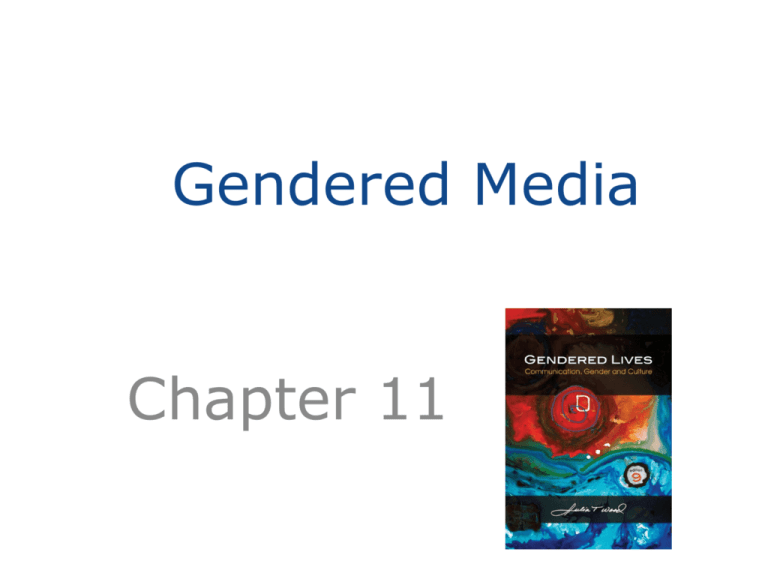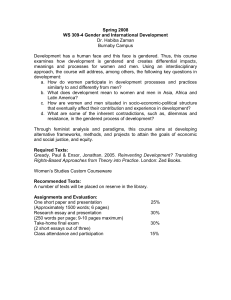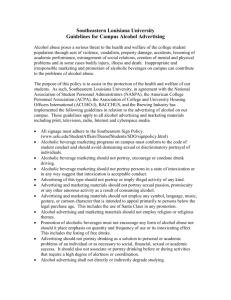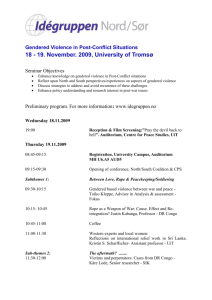
Gendered Media
Chapter 11
Media Saturation
• People today are the most media-saturated
and media-engaged people in history.
• TV, radio, internet, social media, Facebook,
twitter, blogs, YouTube all modern media tools
• Media content can be challenged and changed
Media Saturation
of Cultural Life
• Surveys show most think media affect others
but not themselves – third person effect
• Media sets the agenda – agenda setting
• Media acts as the gatekeeper
• Regulates Images of men and women in
society and underrepresents women and
minorities
Gendered Media Use
• Boys and men use media for instrumental
purposes
• Men more likely to read papers and watch
television to get news or accomplish tasks
• Men also regard media as entertainment
• Men and boys more avid consumers of video
games that are action-oriented or violent
Gendered Media Use
• Girls and women use media to build
relationships
• Girls and women use phone as way to
massage relationships
• Girls and women perceive social media as
allowing them to express themselves
• Girls build online relationships that can be
very intimate
Underrepresent Women and
Minorities
70% of major characters in top-grossing
films are males. Can you think of any
exceptions?
Women are rarely presented as authorities
in news programming
Media also underrepresent and negatively
portray minorities.
Portray Men stereotypically
• Men on prime time are:
–
–
–
–
–
–
–
Independent
Strong
Aggressive
In charge
Typically white, heterosexual
Serious and powerful
confident
Men are NOT portrayed as
•
•
•
•
Non white
Nurturing
Doing housework
Having increasing involvement in home
life and child care which reflects reality
Portray Women Stereotypically
Female characters are seen:
•
•
•
•
•
•
•
Shopping, grooming, being emotional
Flirting and talking about and with men
Being sexual
Engaging in domestic activities
Strong women are also attractive
Typically white
Sexualized / sex objets
Underrepresent Women &
Minorities
• Black characters scarce
– Subordinate, athletic, exotic
• Asians and Hispanics rare
– Males - villains or criminals
– Women - emotional and sexualized
Underrepresent Women &
Minorities
• Older people, mainly women,
underrepresented
– Show few older women
• Elderly stereotyped as sick, dependent,
fumbling, passive
Portray Women Stereotypically
• Representations of women assume
whiteness is norm and ideal
• Depictions of Black women rely on
negative stereotypes of mammies,
jezebels, welfare mothers
Portray Women Stereotypically
• Prominence of white norms for female
attractiveness
– Black women have lighter skin and straighter
hair than typical
– Asian women and Latinas represented as
exotic and sexualized
Portray Women Stereotypically
• Media images reflect stereotypes of
women and femininity
– Women as sex object
– Feminine ideal young and thin
– Preoccupied with men and children
– Enmeshed in relationships or housework
Portray Women Stereotypically
• Female newscasters are young, attractive,
and less outspoken than males
Portray Women Stereotypically
• Reality TV reinforces traditional views of
women and what makes women desirable
Portray Women Stereotypically
• Media limit portrayals of women to two
opposing types: good and bad
– Good
• Pretty, deferential, focused on home and family
• Cast as victims, angels, martyrs
Portray Women Stereotypically
• Media offer bad woman image
– Witch, bitch, whore, iron maiden
• Encounter in children’s literature
Portray Women Stereotypically
• Criteria for good woman challenged
recently
– But if look more closely at nontraditional
images, see woman must also meet traditional
stereotypes of femininity
Portray Women Stereotypically
• Commodified sexuality prominent in
reality TV shows
• Hypersexual identity achieved through
consumption of products and services
Portray Women Stereotypically
• Trend of combining traditional and
nontraditional images of gender in single
character
• See the trailer of Erin Brockovich
– http://www.youtube.com/watch?v=9TjEklyF7
-E
Gendered Advertising
• Advertising’s influence on views may be
more powerful than programmed media
content
– Advertisements are repeated
Gendered Advertising
• Majority of ads emphasize visual images
– Less subject to conscious analysis
• We think we’re immune
– Research suggests differently
Gendered Advertising
• Advertising portrays men and
independent, successful, engaged in
activities
• In some ads, men appear angry – rebels
against authority
Gendered Advertising
• Men in ads have muscular bodies, perfect
hair, teeth
• Contribute to negative self-image and
dangerous behavior
Gendered Advertising
• Advertising directed at men links products
with hypermasculinity and violence
• Men’s dominance is emphasized by
positioning
Gendered Advertising
• Ads for cooking and cleaning products
show men as incompetent
• Also represent men in home situations as
lazy dolts
Gendered Advertising
• Ads represent women as competent in
cleaning and caregiving roles
• Male voice-overs reinforce view of men as
authorities
Gendered Advertising
• Objectification of women
• Highly sexual poses
• Women are perfect, sexy
Gendered Advertising
• Advertising plays role in promoting
appearance and pleasing others
– Emphasize women’s need to change
themselves
– If woman fails man might leave her
Gendered Advertising
• Sometimes advertisers control content of
magazines
– Complimentary copy – articles that increase
appeal of product
Gendered Advertising
• Product placement – showing or
mentioning product in show
• Immersive advertising – incorporates
product in to storyline
Tell How Relate to Each Other
• Most of time, media tell us that women
and men relate to each other in
traditional ways
Dependence/ Independence
• Media portray women as domestic and
dependent on men
• Media portray girls and women as
dependent and boys and men as
independent
Dependence/ Independence
• Books aimed at adolescent females
emphasize importance of being pretty and
popular
• Women and minorities cast in supporting
roles in television shows for children and
adults
Dependence/ Independence
• Beauty more emphasized than health in
women’s magazines
– Magazines aimed at girls brim over with
advice on how to lose weight and look better
Dependence/ Independence
• Music videos portray females as strippers
or prostitutes
• Males shown ignoring, exploiting, directing
women
• Women sexualized and infantilized in video
games
Dependence/ Independence
• There are exceptions
– Law and Order Special Victims Unit
Incompetence/ Authority
• Men shown as authorities who save or
take care of less competent women
– Children’s literature portrays females rescued
by males
• This stereotype occasionally challenged
Incompetence/ Authority
• Newspapers convey message men are
authorities and by near absence or lack of
power - women are not
• More than 2/3 of cited sources are male
Incompetence/ Authority
• Women unlikely to be represented as
experts
• Blacks cast in racially stereotyped roles
Motivate Us to Consume
• Some ads are claimed to help with need
we have identified
• But cultivate desire in us by convincing we
have problems weren’t aware of yet
Incompetence/ Authority
• Women more often represented as
victims on front page
• Stories about powerful women focus
more on appearance and personal lives
Primary Caregivers/
Breadwinners
• Media portrayals of women give little
attention to career activities
• Shown predominantly in roles as
homemakers, mothers, wives
Primary Caregivers/
Breadwinners
• Newspapers and TV news emphasize
men’s independent activities
• Define news as stories about men
– Stories about men focus on work and
achievements
Primary Caregivers/
Breadwinners
• Fewer stories about women
– Emphasize roles as wives, mothers
– Women presented in terms of attractiveness or
unattractiveness
Primary Caregivers/
Breadwinners
• Stories about women’s achievements
mention marriage, family
Victims & Sex
Objects/Aggressors
• Women portrayed as sex objects for men’s
pleasure
• Images show desirable men as aggressive
and dominant
• Images show desirable women as young,
pretty, sexual, vulnerable
Victims & Sex
Objects/Aggressors
•
•
•
•
Men seldom shown nude
Women routinely shown nude
Images common in music videos
Portrayals encourage to see violence as
erotic
Victims & Sex
Objects/Aggressors
• Hip-hop, rap, gangsta rap carry messages
about relationships between women and
men
– Portray women as sex objects
– Portray men as egocentric, insensitive abusers
Victims & Sex
Objects/Aggressors
• Adolescents who listen to music with
highest level of sexually degrading lyrics
more likely to engage in sex
Victims & Sex
Objects/Aggressors
• Much of rap glorifies violence
– Conveys messages about gender and race
Motivate Us to
Consume
• Media
encourage us
to consume
• If we buy
product or have
procedure will
look better
Motivate Us to Consume
• Media encourage us to perceive normal
bodies and normal physical functions as
problems
– Unacceptable, defective
Motivate Us to Consume
• Advertising increasingly focused on girls
– Girl power is reduced to purchasing power
– Encourages them to aspire to sexualized
image
Motivate Us to Consume
• Media pathologize male bodies
– Bodybuilding trend created unrealistic and
unhealthy ideals
• Contributes to increasing abuse of steroids among
men
Motivate Us to Consume
• Normal changes in men’s sexual vigor
represented as problems
• Not problem until drug companies
decided could make money
Motivate Us to Consume
• Advertising effective in convincing need
products to solve problems
– Normal body weight for women abnormal
– Encouraged to cover up gray hair
– Facial lines can be removed
Motivate Us to Consume
• Belief women should remove body hair
grows out of media campaign
• Hair removal campaign has recently
targeted men
Motivate Us to Consume
• Many women’s breast size exceeded
cultural ideal in 1960s
– Breast reduction surgeries increased
Motivate Us to Consume
• By 1980s, cultural standards changed to
define large breasts as ideal
– Breast augmentation surgeries accelerated
– Surgery can lead to disfigurement and loss of
sensation
Motivate Us to Consume
• More women having parts of toes
removed
– Improves toe cleavage
• Can fit into pointed-toe shoes
Motivate Us to Consume
• Surgeries to conform to white ideals on
the rise
Motivate Us to Consume
• Efforts to pathologize natural physiology
can be serious
– Emphasis on excessive thinness contributes
to severe dieting and eating disorders
Motivate Us to Consume
• Most top female models are skeletal
• Dangers include heart attack, stroke, liver
disease
• Dangers exist for men who use steroids
Assess Ourselves Unfairly
• Unrealistic images encourage us to see
ourselves as inadequate
• Portrayals of relationships between men
and women also unrealistic
Assess Ourselves Unfairly
• Most encounter problems in relationships
that can’t be solved in 30 minutes
• Most will not be able to pursue career and
be relaxed and always available to family
and friends
Assess Ourselves Unfairly
• Readers of self-help books have less
realistic ideals
– Experience more frustration and
disappointment
– Likely to be dissatisfied with real, normal
relationships
Assess Ourselves Unfairly
• When besieged with impossible images,
difficult not to feel inadequate
– May feel we and our relationships are inferior
– Research supports this
Normalizing Violence Against
Women
• Naïve to claim media cause violence
• Mounting evidence media contributes to
increasing male violence
Normalizing Violence Against
Women
• After watching sexually explicit films that
degrade women, men become more
dominant toward women
• When see violence in media, come to view
as commonplace, acceptable
Normalizing Violence Against
Women
• Video games push envelope of mediated
violence
– Some researchers think violent games
harmless
– Majority of scholars think games dangerous
because engage one virtually in violence
Normalizing Violence Against
Women
• Social learning theory claims we engage in
behaviors that are rewarded and avoid
behaviors that are punished
Normalizing Violence Against
Women
• Cognitive development theory focuses on
use of role models on which to base
behaviors and identities
• Symbolic interactionism highlights
importance of social views in shaping
identities





